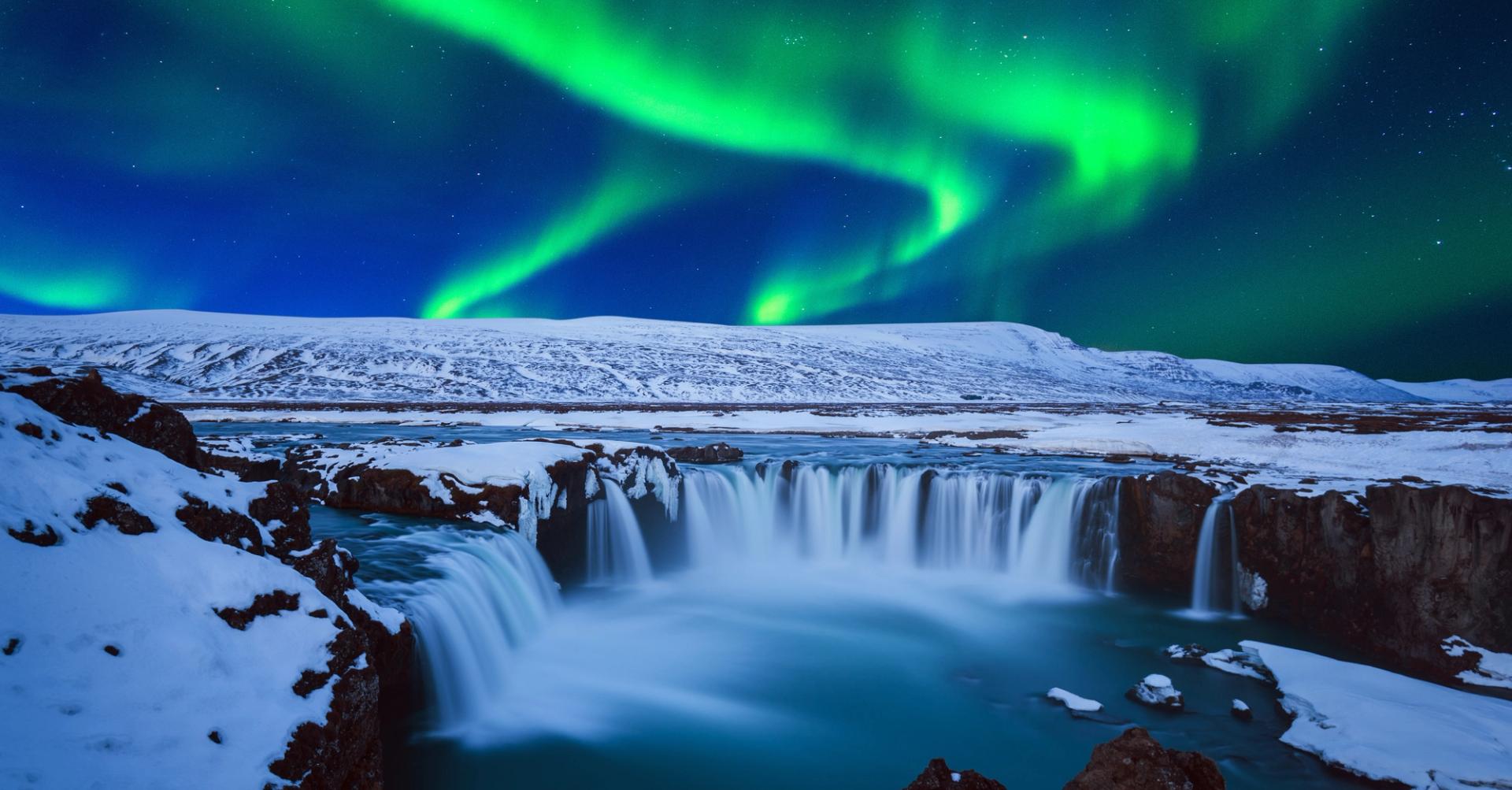 Itineraries
Itineraries18 Must-Sees in North Iceland
Iceland is technically a small country, with big places to explore. The country has over 6400 miles of land, making it double the size of Denmark. It is also roughly the same size as the state of Kentucky, which is in America. There are generally four sides of the country, the east, west, south, and north. Each provides a unique adventure for you to enjoy. From waterfalls to volcanoes, we are going to break down the 18 must-sees in Northern Iceland. And what makes them so special?
Dettifoss waterfall
Start your Northern Iceland adventure with a trip to Dettifoss Waterfall. The second most powerful waterfall in Europe, after the famous Rhine Falls in Switzerland of course. The waterfall is 147 feet high and 328 feet wide, which is also why it is sometimes referred to as “The Beast”.
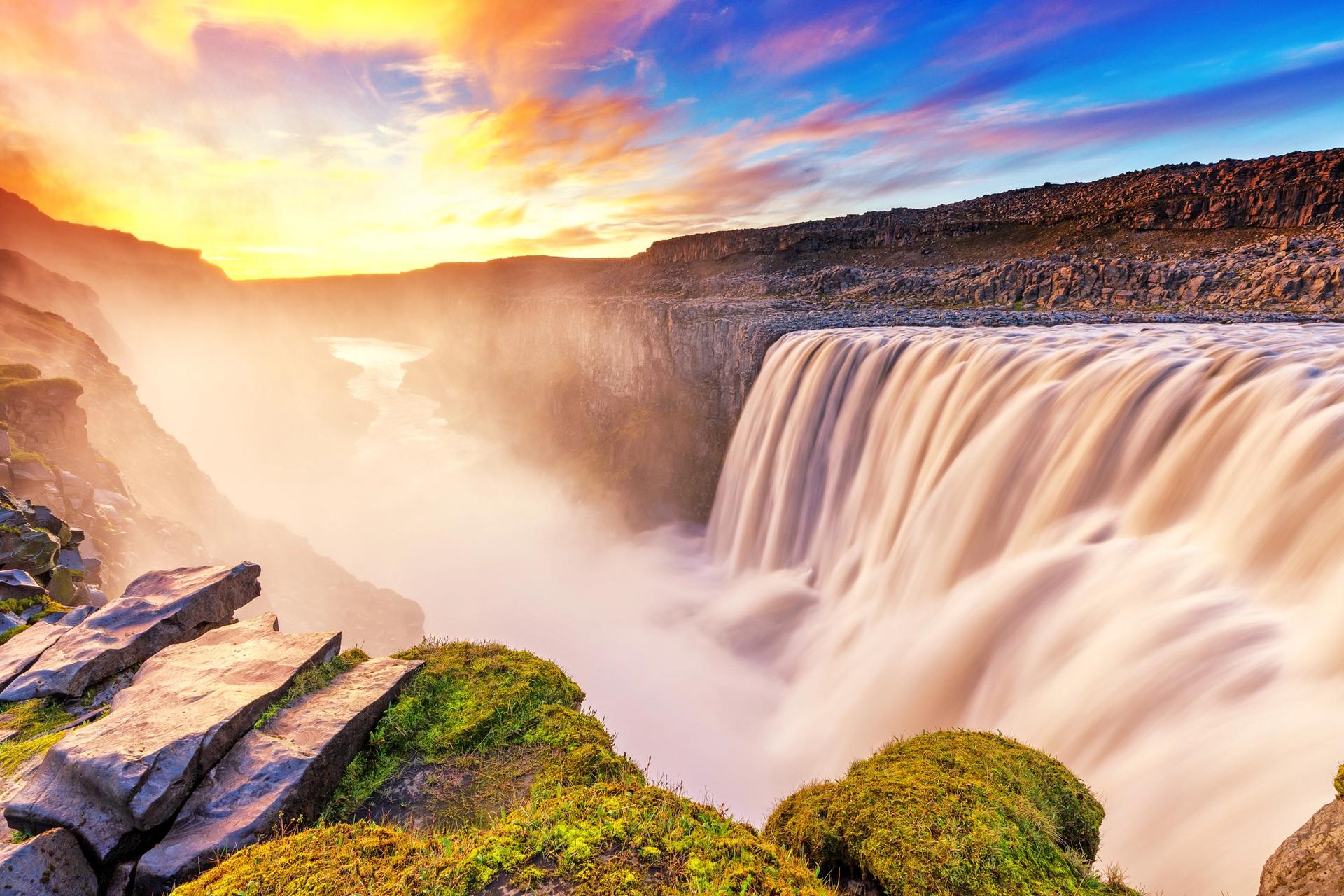
The strong water comes from the Jökulsá á Fjöllum glacier river. Which flows from the Vatnajökull glacier, the largest ice cap in Europe, and of course, Iceland. The waterfall is located inside the infamous Vatnajökull National Park. If you are taking the Ring Road, you can detour north to visit Dettifoss. Once you arrive, you just take a short ten-minute walk to the waterfall. Most of it will be down a rocky trail. The steep yet easy hike is well worth the majestic views of Dettifoss.
Hvitserkur
Have you ever seen a dragon? How about an elephant made out of stone? In Northern Iceland you kind of can, by visiting Hvítserkur. This is a 49-foot basalt rock stack on the Vatnsnes peninsula's shore. The rock has two large holes at the bottom of it. This causes Hvítserkur to appear as a dragon drinking. Others say the rock appears to look like an elephant or a large bison. But we prefer to go with a dragon for today.
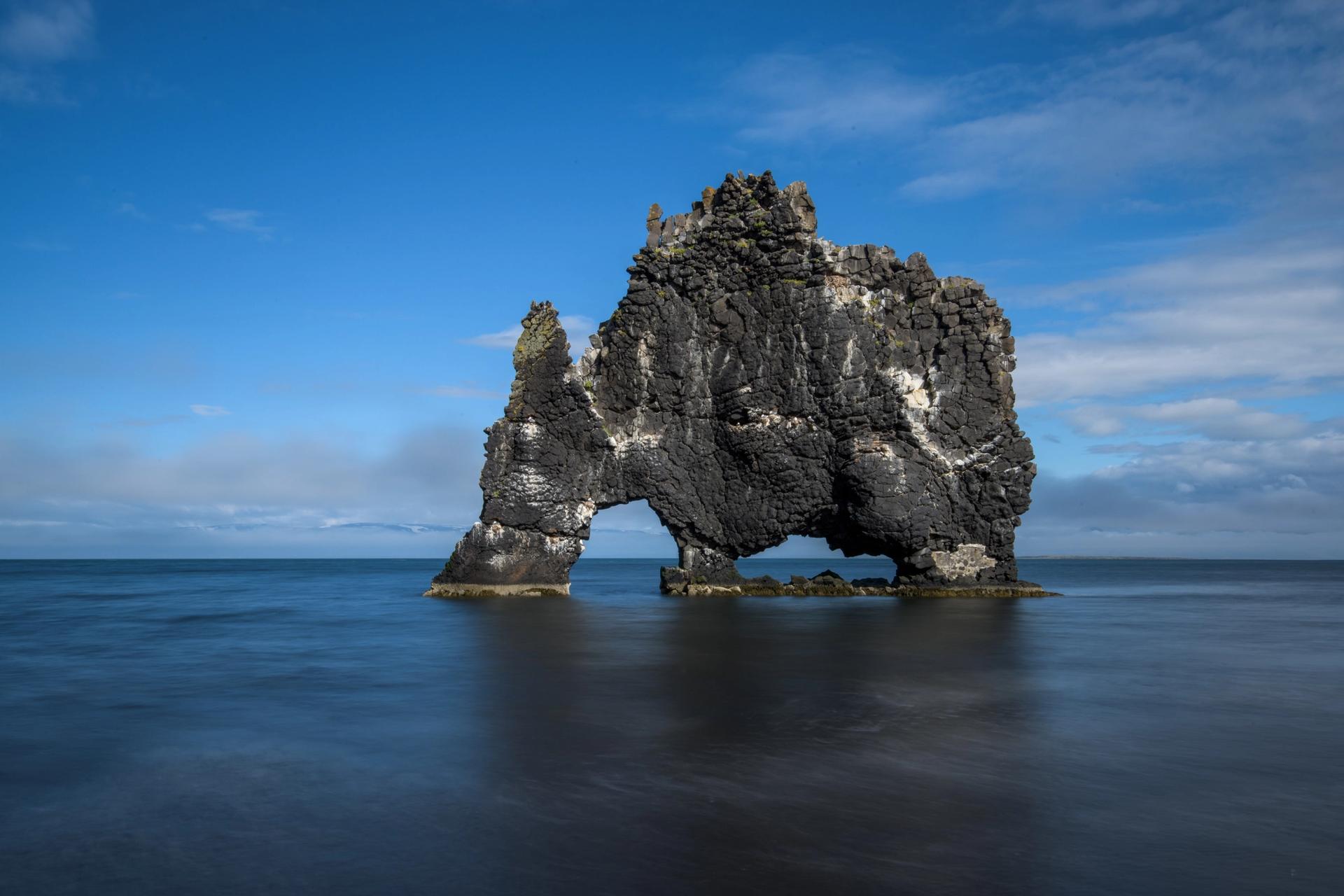
There is a legend surrounding this rock that sits in the sea. Some say that Hvítserkur is a petrified troll. The rumored troll resided in Strandir, which is in the West fjords. He then wanted to tear down the bells at the Þingeyraklaustur convent. While trying to do this, the sun rose and the troll turned into stone, creating Hvitserkur.
While it is a quick stop, it is most certainly worth it. If you visit during the summer months you can spot the Fulmar birds. Use your imagination when visiting Hvítserkur, a fun, and quirky stop during your Northern Iceland adventure.
Krafla Volcano
Krafla Volcano has erupted a whopping 29 times, with its last eruption taking place in September of 1984. Krafla is located on the Mid-Atlantic Ridge, a divergent boundary between the North American Plate and the Eurasian Plate.
Víti is an explosion crater that is located in the Krafla Volcano. It is a stunning lake that was caused by the volcanic eruption in 1724. This explosion ended up lasting for five years and was called the Mývatn Fires. Today the Viti attracts visitors from all over the area due to its turquoise green and blue water. It is important to know that you absolutely cannot swim in the Viti. The temperature is unbearable and would injure anyone who attempted this. At one point in time, you could bathe in these waters. But after the eruption which occurred between 1975 and 1984, the water spiked upwards in temperature. This Viti and Volcano are better enjoyed from afar, where you can still take in the scenery of Krafla.
Myvatn Nature Baths
Now let’s discuss a place where you can swim, Myvatn Nature Baths. An Iceland lagoon that features its milky blue swimmable waters. So how did the water get here? The lagoon water runs straight from the National Power Company´s bore hole in Bjarnarflag.
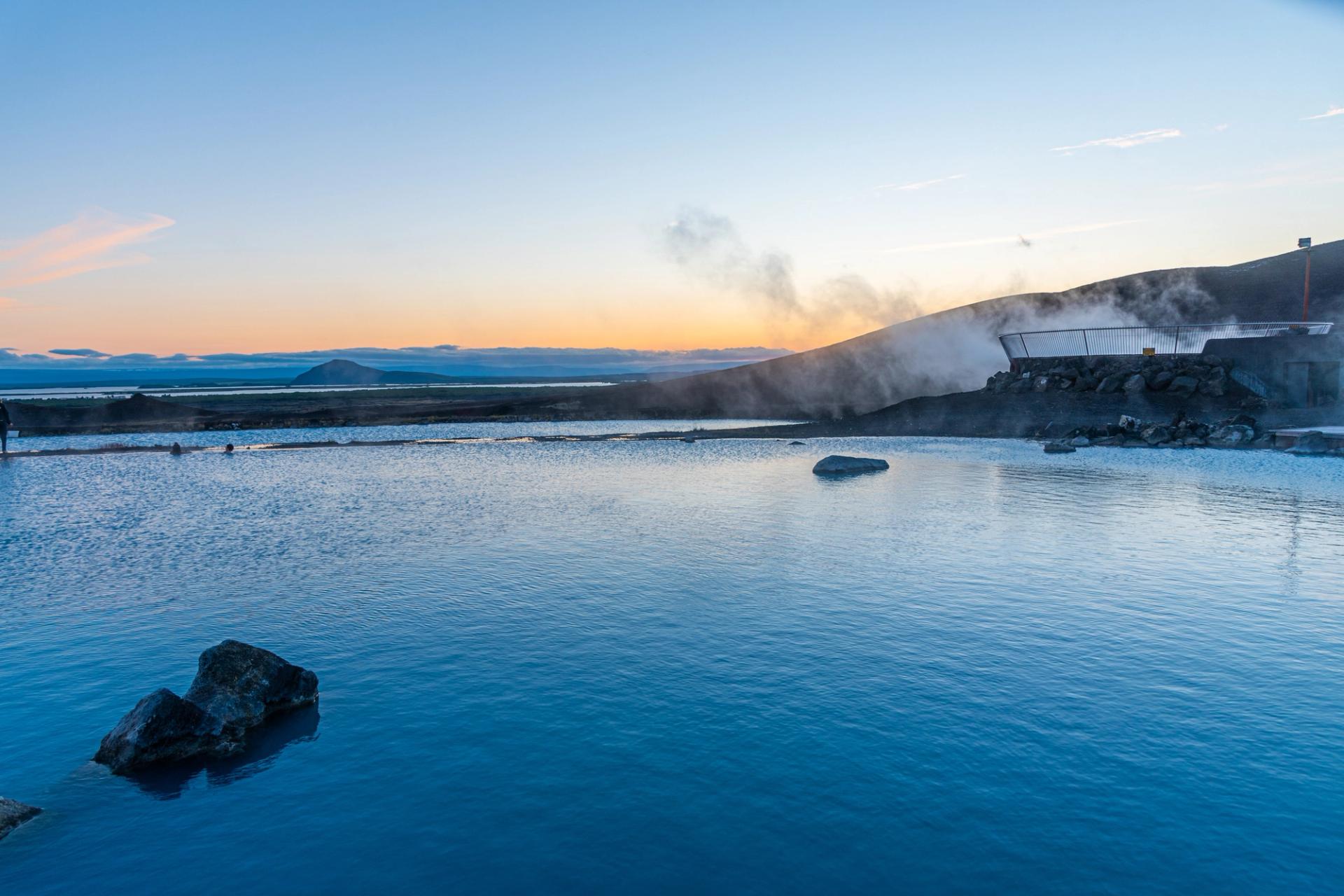
The temperature reaches about 266°F when it arrives at the huge basin beside the lagoon. Don’t worry, that temperature cools down significantly in the lagoon due to it holding around 3.5 million liters of water. The temperature of the lagoon then sits at 96 – 104°F, perfect for soaking.
The lagoon even has a swim-up bar! Grab an alcoholic or nonalcoholic beverage to enjoy while you bathe your body. Then, end your day by relaxing in the steam bath. The steam rises directly through the floor and is completely controlled by the weather. The temperature sits at 113°F, with the humidity close to 100%. Enjoy the views of Iceland from the large steam bath windows at the breathtaking Myvatn Nature Baths.
Husavik
Visit the loved Northern Iceland town of Húsavík. It is located next to Skjálfandi Bay, which is northeast of Akureyri. This town is the oldest settlement in Iceland. It is also famous for its whale watching opportunities. Húsavík is actually known for being the Whale Watching Capital Of Iceland. Locals say that there is a 97% average success rate of sighting a whale within the last three decades. Spot one of the 24 species of different whales yourself when visiting Húsavík.
If getting out on the water is not your vibe, you can visit the Húsavík Whale Museum instead. This non-profit organization was established in 1997, on the shores of Skjálfandi Bay, just below the Arctic Circle at 66° N. It was first a very small exhibit on whales in a town's hotel then after 1997, the exhibition was moved into the newly renovated part of the baiting shed at the harbor. In 2000, the town's old slaughterhouse was bought, remodeled, and officially opened in June 2002. Now you can visit the museum which has 8 exhibition rooms and is one of few museums in the world solely dedicated to whales.
Lake Mývatn
Have you ever wanted to visit a volcanic lake? If yes, Lake Mývatn can help you make that dream a reality. The lake is located on the northeastern shore of Reykjahlíð village. Mývatn. Which is a region of lakes, with an area of 14 square miles. This makes Lake Mývatn Iceland's fourth-largest body of water. The lake itself is relatively shallow and has mineral-enriched water, providing nutrition and energy
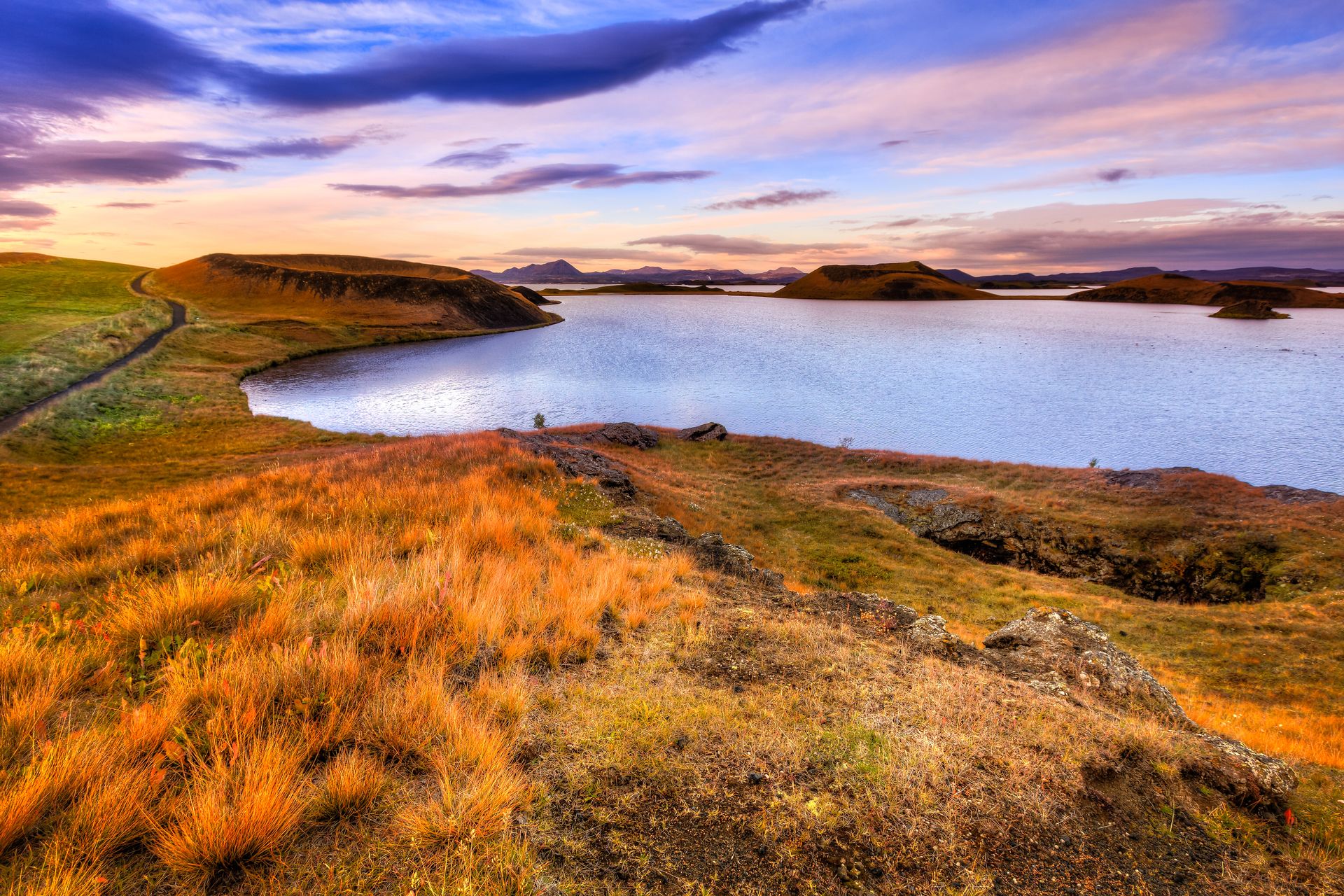
Swimming is not allowed here due to the water being too warm. However, there is plenty of wildlife here. There are different types of fish found in the lake, including a variety of trout and arctic char. Over 58 different birds are spotted in the area too. Including Mallard, Greylag Goose, Grey Heron, Snowy Owl, and the White Tailed Eagle. End your trip to the lake by visiting the Sigurgeir’s Bird Museum, which opened in 2008. The museum has about 330 stuffed birds and about 500 eggs. The gallery has 280 birds and 300 eggs on display. The museum has all Icelandic breeding birds except the sea eagle! An educational spot to truly learn all about the area of Lake Mývatn
Laufás Turf House
Let's explore Laufás Turf House, which belongs to the National Museum of Iceland. This historic place showcases actual turf houses that housed 20-30 people in Laufás back in the 1900s. You can marvel at the old architecture and truly see how Icelanders lived back then.
So what is a Turf House? It is a home constructed of Flat stones, wood, turf, and soil. A wooden frame would be built first as the foundation. Then the turf would be laid down on the frame, normally a few layers. Iceland only had 30% of its land forested during this time. Wood was in high demand, so the locals had to get creative. This helped provide shelter from Iceland’s frigid climate.
While turf houses are normally a bit smaller, Laufás was considered a wealthy area. Parts of the turf house date back all the way to 1840, a truly historic site. You can purchase tickets at the visitor center upon entry. We recommend taking a walk around and looking inside these amazingly built turf homes.
Geosea
Experience the “Heat of the North” at Geosea Geothermal Spa! Over the last century, hot water was drilled on Húsavíkurhöfði. As a result, the bathing water came to the surface which was enriched in minerals. The water does have a combination of clear rock water and ground sea and is known to even improve your health.
This world-class spa is not only known for its relaxing pools, but also for its gorgeous design. Take in the view of Skjálfandafló with the Arctic Circle in the distance. The entrance fee into the spa is 5.500 ISK or $40 USD. You can rent towels, a swimsuit, and even a bathrobe. On sunnier days, they open up their terrace for a stunning dining experience. Geosea is a must-see when visiting Northern Iceland, whether it is winter or summer.
The Arctic Henge
Get ready to stop by Raufarhöfn, which is a remote village in Northern Iceland. Here you can visit the Arctic Henge, also known as Heimskautsgerðið. While England has Stonehenge, Iceland has the Arctic Henge. They are both similar as they both have a sundial, which will capture the sun's rays. This will cause shadows to cast in a perfect location that captures the light between aligned gateways. Setting up photographers to capture their perfect shot. Sunset is the recommended time to go for a gorgeous photograph. Some even stay and try to capture the Northern Lights in the winter months.
Haukur Halldórsso designed the Arctic Henge project in the late 1990s. It honors folklore and the 72 dwarfs who are known to be symbols of the seasons of the world. Each individual block is inscribed with one of the dwarf's names. Today it is still under construction and is not fully completed. But, it is still one hundred percent worth the stop during your Northern Iceland road trip.
Siglufjordur
The small fishing village of Siglufjordur is a must-see during your road trip. This town became one of the largest settlements in Iceland in the 20th century. It thrived by being the capital of herring fish in the North Atlantic. You can visit The Herring Era Museum, which will teach you all about this historic time. The museum is the only of its kind in the whole world! Their exhibits include the 'Brakki', which is a grand monument to the Norwegian influence in the Icelandic herring industry.
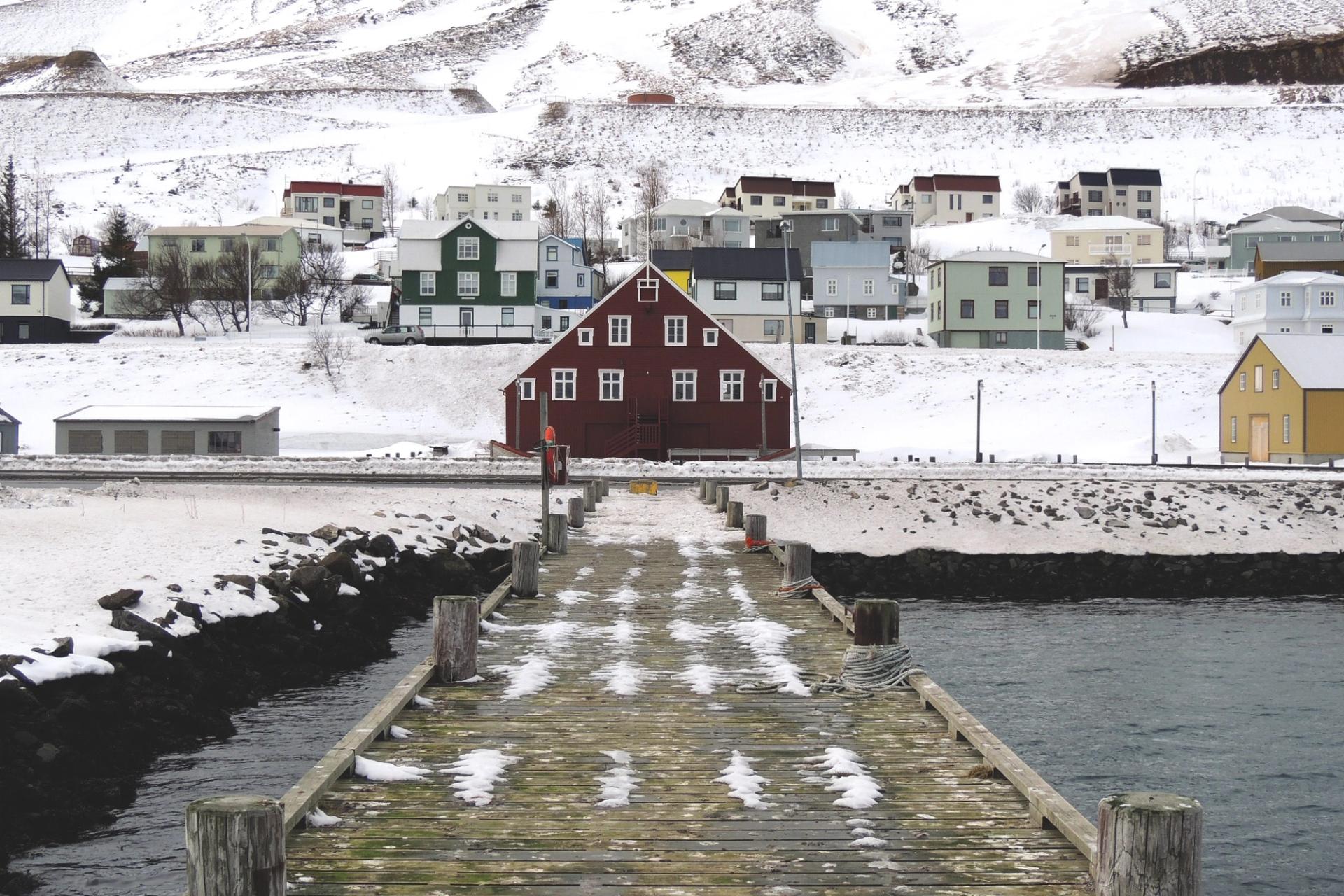
Visiting in July? If yes, you can partake in the Folk Festival. The festival showcases folk music from nations around the world. With an extra special focus on Iceland specifically. In addition to the music, there are courses and teachings on music. The festival wouldn't be complete with parties and concerts too. They have over 19 concerts that take place during the festival.
A little town that is packed with so much history. Did we mention that Siglufjordur is absolutely gorgeous too? Enjoy the mountain backdrop which compliments the blue harbor.
Skagafjörður valley
Calling all horse lovers, Skagafjörður is waiting for you. This valley in Iceland is a famous district for Icelandic horses. It is sometimes referred to as the Mecca of horsemanship. It is a very large valley that reaches south towards the Hofsjökull glacier.
After you view the horses, visit Grettir’s Pool, a famous attraction in the area. The pool is named after Grettir Ásmundarson, who was known to be the strongest man in the Icelandic Sagas. The pool is unique as it is built with stones. The water is very warm at 100°F, making it a relaxing stop. Since the pool is technically located on private property, there is an entrance fee to access it. A small yet gorgeous pool that provides views of the sea.
Ásbyrgi canyon
Visit the famous horseshoe-shaped Ásbyrgi canyon. Which is also known as the “Shelter Of The Gods”. The canyon sits inside Vatnajokull National Park. The cliffs of the canyon are an impressive 330 feet high, drawing tourists from all over. Ásbyrgi canyon allows you to visit where the canyon divides, a spot that is known for its breathtaking views.

The canyon got its name from the Old Norse Gods. The tale goes that the shape of the horseshoe canyon was created by the stomping of one of the hoofs of the eight-legged steed of Odin. If you want to explore overnight, you totally can! They have a first come first serve campground at the canyon.
Goðafoss waterfall
Explore the waterfall of the gods, also known as Goðafoss waterfall. This breathtaking waterfall is located right off of Ring Road, making it a quick stop along your route. The height of Goðafoss is 39 feet, with an angle of about 98 feet. The waterfall is located in the river Skjálfandafljót. Which is the fourth-largest river in Iceland.
Spend your day taking a short hike to the waterfall. The trail is 1.8-miles long with an out-and-back trail. The trail will provide plenty of views of Goðafoss from a few different angles. This is a special place, packed with history. It is said that in the year 1000, the Viking Leader, Þorgeir Ljósvetningagoði, named Christianity the official religion of Iceland. He then tossed his statues of the Norse gods into these waters.
After you spend some time marveling at the waterfall, stop by Godafoss Café for a bite to eat. Some menu items feature delicious pizza and hot cappuccinos.
Dimmuborgir
Also located in the Lake Mývatn area are the Dimmuborgir lava formations. This area is also known as the “Black Fortress'', due to its dramatic landscape. Over two thousand years ago Dimmuborgir was formed because of an eruption. The whole area is known for its high volcanic activity. It is a unique location to walk around while admiring the majestic rock formations.
In addition to the volcanic land, Dimmuborgir is also the home to the ‘Icelandic Santa Clauses. Which are known as the 13 Father Christmases or the Yule Lads. Every Christmas, these merry but mischievous fellows take turns visiting children on the 13 nights leading up to the holidays.
Every night, children all over Iceland place one of their shoes on the windowsill for them. If you were good over the past year, the Yule Lad will leave candy. If you were bad, they will fill the shoe with rotting potatoes. These little tricksters have become a staple in Iceland, so you have to visit their rumored home. An exquisite place that has some quirky folklore history for you to enjoy when visiting Northern Iceland.
Dalvik
Spend some time at “Valley Bay”, otherwise known as the town of Dalvik. A famous fishing port that draws tons of visitors to North Iceland. Relax at Dalvík Harbor, which is a fishing and commercial port. You can even take the ferry Sæfari, which sails to the island of Grímsey. The ferry takes 3 hours each way, making it a full-day trip! If you are visiting in the winter. The ferry has three to four departures a week. In the summer it has five departures a week.
If you are lucky enough to visit in August, you can join them at their Fish Festival. Also known as the Great Fish Day. This unique event has attracted over 200,000 guests. You can enjoy free fish tastings, a delicious way to try some of the town's favorites. Live music is always a great addition, so enjoy taking in the sea breeze while strolling around Dalvik.
Grjotagja Cave
Have you ever visited a small lava cave? You can by visiting Grjotagja Cave in Northern Iceland. While you cannot go inside the cave you can explore the area by a rental car. The cave is historic in Iceland and is even known by the locals to be a home for trolls. Back in the 18th century, it was said the trolls hid in the dark and icy caves.

Located deep in the cave is a geothermal hot spring. In the 1970s, locals used the cave waters as a hot spring. Today, bathing is no longer allowed due to the range of temperatures rising, a result of volcanic eruptions. Because of this, the 122F hot springs cannot be accessed at this time. It has been used as a filming location for popular tv shows and movies, including the favored Game Of Thrones. The scenes were shot in a studio, but it is still a beautiful way to see it.
Akureyri
A trip to Northern Iceland wouldn’t be complete without visiting Akureyri. Which is also known as the “Capital Of The North”. There is truly so much to do in this loved town. Visit The Botanic Gardens or The Art Museum and Art Street. Spend your day at Sundlaug Akureyrar, a Public Swimming Pool. Which is also home to the longest water slide in Iceland. In addition to two heated outdoor swimming pools, five hot tubs, a sunbathing area with deck chairs, a children‘s pool, a steam bath, a cold bath, and two more water slides. A fun place to spend some time outside!
After enjoying the town, you have to try the Akureyri Pizza. Bryggjan has this famous pizza, which is slathered in bearnaise sauce and French fries. I couldn’t think of a more appetizing way to explore the town of Akureyri.
Grimsey Island
The small North Icelandic island of Grimsey is a bucket list place to visit. It is a very small island that straddles the Arctic Circle. If you are a bird lover then this is the spot for you, with over one million different species of birds in the area. One of these birds is the adorable puffin! They are normally spotted from the end of April until the beginning of August. There are no Puffins on Grímsey Island during winter.
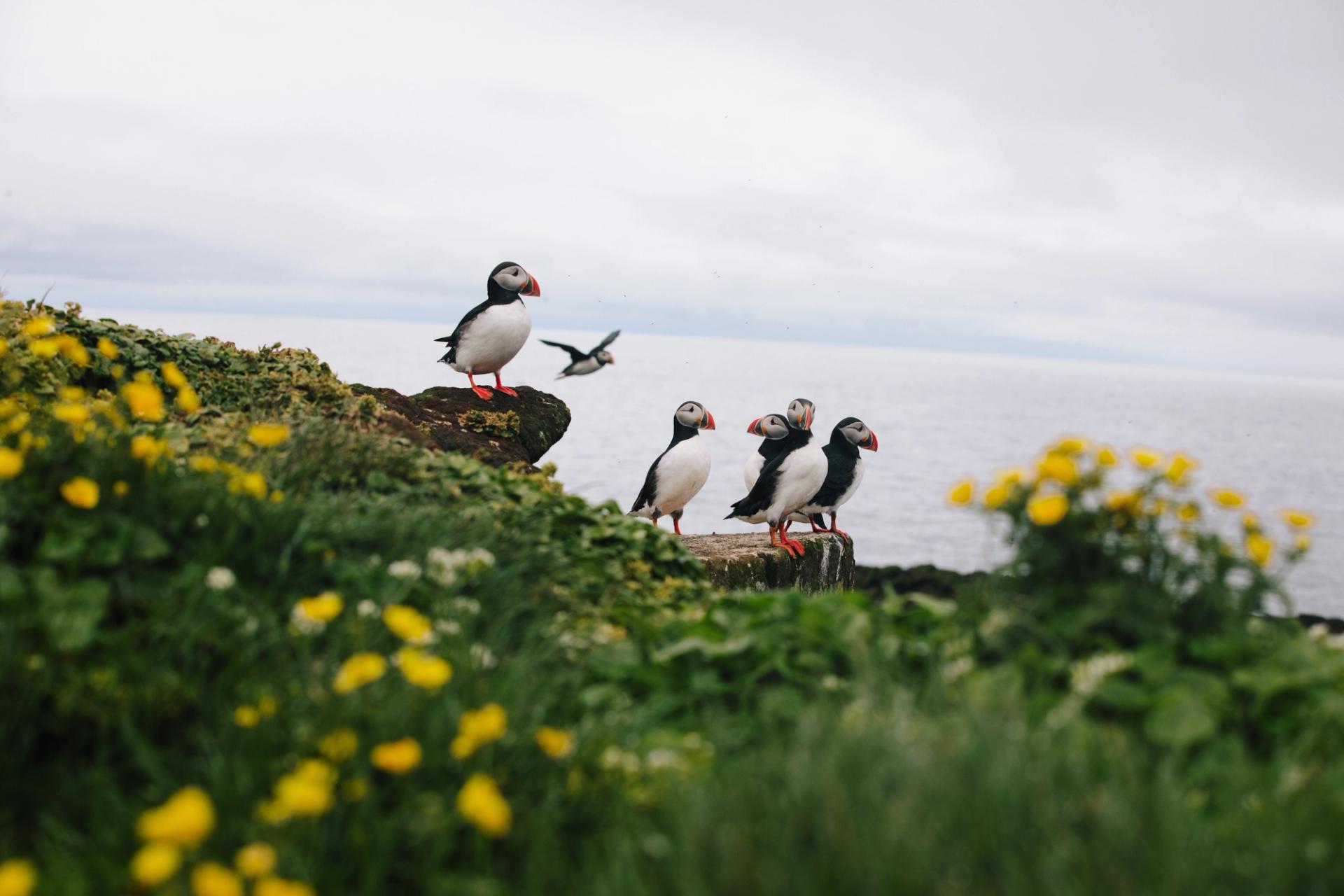
Other than bird watching, there are plenty of activities for you to try. There are walking and hiking paths on the island, including the four-mile Blue Trail: Across the Arctic Circle hike. Bike riding, boat tours, and fishing are other popular ways to spend your day. Join Grimsey’s train ride which will bring you to the lighthouse at the southernmost point of the island and then back through the village to the old Arctic Circle Monument close by the airport. An easy way to explore the island.
As discussed earlier, you can take the ferry Sæfari from Dalvik to reach the island. There is also a small airport where you can fly from Akureyri Airport or even Reyjavik.
Latest Blog Posts
 Guides
GuidesThe 2022 Eruption of Fagradalsfjall Volcano - An Unforgettable Iceland Volcano Eruption
Iceland has become a top destination for mind-blowing mountain hikes, volcanic hot springs, and icy glaciers. Adventurers flock to the land of fire and ice to experience these thrilling opportunities! So it is no wonder why Iceland's volcanic eruptions attract visitors from all over the world!
 Waterfalls
WaterfallsGuide to Svartifoss Waterfall in Iceland
Svartifoss, or the 'Black Waterfall', is an exquisite natural wonder tucked away in the Vatnajökull National Park of Iceland. Known for its distinctive basalt columns and cascading water, this waterfall is a must-see for nature lovers and travelers.
 Itineraries
ItinerariesTop 11 Must-Visit Volcanic Sites in Iceland
Iceland has over 130 volcanoes located throughout the country, with 30 of them still active today. Some of them are famous for recent volcanic eruptions, while others have not erupted in thousands of years. There are so many notable Iceland volcanoes, it is hard to know which ones you can visit. With the nickname of The Land of Fire and Ice, you know you won’t be disappointed when it comes to Iceland's volcanic sites. Here are our top 11 must-visit volcanic sites in Iceland!